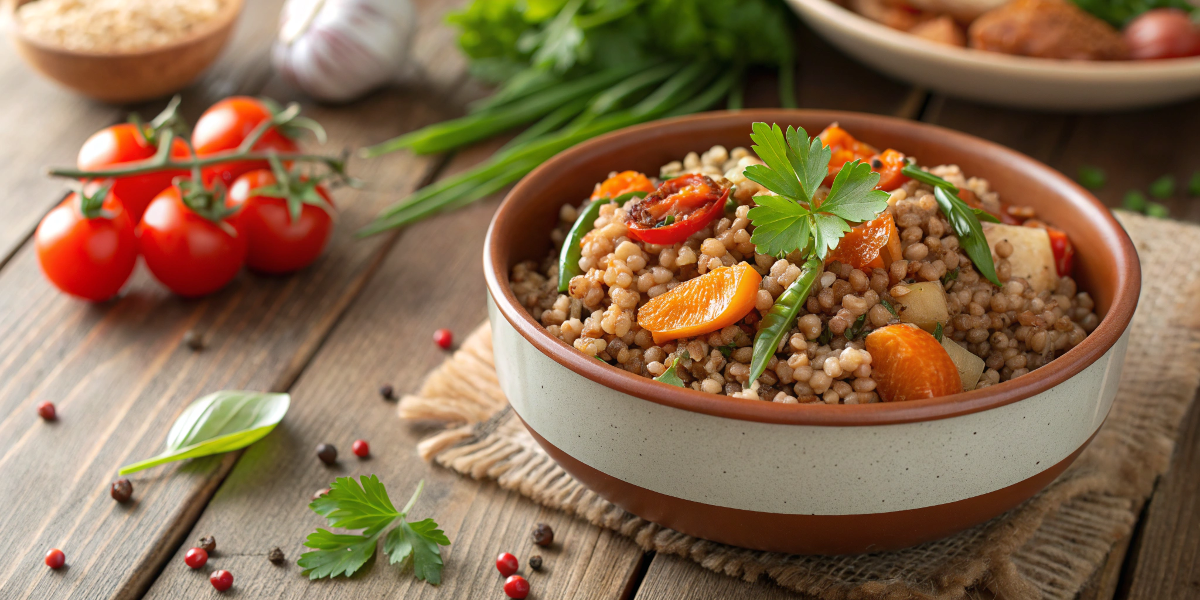Introduction
Recipes with buckwheat are a versatile and nutritious way to enjoy meals that are both delicious and healthy. If you’ve ever wondered what you can make with buckwheat, the options are endless: try buckwheat pancakes or buckwheat bread for a hearty breakfast, kasha or pilaf for a savory lunch, buckwheat noodles (soba) for dinner, or even buckwheat muffins and cookies as wholesome snacks. Its nutty flavor pairs beautifully with fruits, vegetables, cheese, or chocolate, making it suitable for sweet and savory recipes alike.
Buckwheat is naturally gluten-free, high in fiber, and rich in protein, magnesium, and antioxidants. Including recipes with buckwheat in your daily diet not only enhances taste but also supports heart health, digestion, and sustained energy levels. From traditional international dishes to modern creative meals, buckwheat is a superfood that can be incorporated into virtually any menu.
Print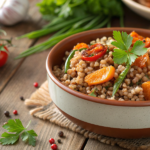
Recipes with Buckwheat: 10+ Healthy and Delicious Ideas
- Total Time: 30 minutes
- Yield: 4 servings 1x
Description
Recipes with buckwheat are a versatile and nutritious way to enjoy meals that are both delicious and healthy. From pancakes and bread to kasha, soba noodles, and muffins, buckwheat fits into sweet and savory recipes alike. Its nutty flavor pairs beautifully with fruits, vegetables, cheese, or chocolate, making it a true superfood for everyday cooking.
Ingredients
- 1 cup buckwheat groats
- 2 cups water or milk (for porridge)
- 1 cup buckwheat flour (for pancakes or baking)
- Fresh fruits (bananas, berries, apples)
- Vegetables (spinach, mushrooms, zucchini)
- Herbs and spices (cinnamon, garlic, parsley)
- Protein options (tofu, cheese, beans, eggs)
- Sweeteners like honey or maple syrup
- Cooking oils or butter
Instructions
- For porridge: simmer 1 cup buckwheat groats with 2 cups water or milk for 15 minutes until tender, then top with fruits, nuts, or honey.
- For pancakes: mix buckwheat flour with baking powder, eggs (or flax egg), and milk. Cook on a greased pan until golden.
- For savory bowls: cook groats, then mix with roasted vegetables, beans, or tofu and add dressing.
- For soba noodles: boil noodles, rinse, and serve cold with dipping sauce or hot in soup.
- For pilaf: sauté onions, garlic, and vegetables, add buckwheat groats, pour water, and cook until fluffy.
- For snacks: bake muffins, cookies, or bars using buckwheat flour combined with sweet or savory add-ins.
Notes
Toast buckwheat groats before cooking to enhance nutty flavor. Store cooked groats in the fridge for up to 4 days or freeze in portions for quick meals.
- Prep Time: 10 minutes
- Cook Time: 20 minutes
- Category: Healthy Recipes
- Method: Stovetop / Baking
- Cuisine: International
Nutrition
- Serving Size: 1 portion
- Calories: 250
- Sugar: 5g
- Sodium: 50mg
- Fat: 6g
- Saturated Fat: 1g
- Unsaturated Fat: 5g
- Trans Fat: 0g
- Carbohydrates: 45g
- Fiber: 5g
- Protein: 8g
- Cholesterol: 0mg
Keywords: recipes with buckwheat, gluten-free, healthy, porridge, pancakes, soba noodles, kasha
Why Cook with Buckwheat
Nutritional Powerhouse
Buckwheat is more than just a grain alternative—it’s a nutritional powerhouse that can easily boost your daily diet. Despite its name, buckwheat isn’t actually wheat; it’s a seed that’s naturally gluten-free, making it perfect for anyone with celiac disease or gluten sensitivities. Packed with fiber, plant-based protein, and essential minerals like magnesium, iron, and manganese, buckwheat helps maintain energy levels and supports overall health. Additionally, it contains antioxidants like rutin and quercetin, which can promote heart health and reduce inflammation.
Using buckwheat in your recipes is a simple way to add nutrition without sacrificing flavor. From hearty breakfasts to savory dinners, this versatile ingredient fits into almost any meal. Its earthy flavor pairs wonderfully with vegetables, nuts, fruits, and spices, giving your dishes depth and character.
Why People Feel Good After Eating It
One of the reasons buckwheat has become so popular is that it doesn’t just nourish the body—it also makes you feel good. Thanks to its high fiber content and complex carbohydrates, buckwheat provides slow-release energy, helping stabilize blood sugar levels and preventing sudden energy crashes. Many people notice improved digestion after including it in their diet, as the soluble fiber helps regulate bowel movements.
Furthermore, buckwheat contains tryptophan, an amino acid that supports serotonin production, the “feel-good” neurotransmitter. This can subtly elevate mood and promote a sense of well-being. Whether eaten as a breakfast porridge, a hearty lunch, or a comforting dinner, buckwheat is a natural mood booster that supports both physical and mental health.
Possible Downsides
While buckwheat is highly nutritious, there are a few points to consider. Its strong, earthy taste may not appeal to everyone, especially when eaten plain. Some people may find raw buckwheat difficult to digest, so it’s generally best to cook or toast it before eating. Additionally, while rare, buckwheat allergies can occur, so it’s important to introduce it gradually if you haven’t eaten it before.
Despite these minor downsides, the benefits of incorporating buckwheat into your daily meals far outweigh the drawbacks. Once you experiment with different cooking methods, you’ll find ways to enjoy its unique flavor while reaping its nutritional rewards.
Why Cook with Buckwheat
Nutritional Powerhouse
When it comes to healthy cooking, recipes with buckwheat are among the most versatile and nutritious choices you can make. Buckwheat isn’t actually wheat—it’s a seed that’s naturally gluten-free, making it perfect for anyone looking for healthy alternatives in their meals. Many people include buckwheat in their diet because it’s packed with fiber, plant-based protein, and essential minerals like magnesium, iron, and manganese.
Including recipes with buckwheat in your daily meals can help you maintain steady energy, support digestion, and provide important antioxidants like rutin and quercetin, which promote heart health and reduce inflammation. Its unique, nutty flavor makes it suitable for a wide range of dishes, from breakfast porridges and pancakes to hearty dinners and savory pilafs.
Why People Feel Good After Eating It
One of the reasons recipes with buckwheat are so popular is that they not only nourish the body but also make you feel good. The fiber and complex carbohydrates in buckwheat provide slow-release energy, stabilizing blood sugar levels and preventing energy crashes. Many people notice better digestion after adding buckwheat to their diet, thanks to its soluble fiber that promotes gut health.
Moreover, buckwheat contains tryptophan, an amino acid that supports serotonin production—the neurotransmitter that enhances mood. That’s why enjoying recipes with buckwheat in your breakfast, lunch, or dinner can leave you feeling satisfied and uplifted throughout the day.
Possible Downsides
While recipes with buckwheat are generally beneficial, there are a few minor considerations. The earthy taste may not appeal to everyone, and raw buckwheat can be difficult to digest, so cooking or toasting is recommended. Rarely, some people may have buckwheat allergies, so it’s wise to introduce it gradually.
Despite these small downsides, the health benefits and versatility of buckwheat make it a fantastic ingredient for anyone interested in wholesome, nutrient-packed meals. From porridge and pancakes to salads and pilafs, recipes with buckwheat offer endless possibilities in the kitchen.
Everyday Buckwheat Recipes
Breakfast Ideas
Starting your day with recipes with buckwheat is a delicious and nutritious choice. Buckwheat porridge is one of the simplest and most satisfying options. Cook buckwheat groats in water, milk, or a plant-based alternative, and top with fruits, nuts, and a drizzle of honey or maple syrup. The nutty flavor of buckwheat complements sweet toppings like berries, banana slices, and cinnamon, making breakfast both flavorful and wholesome.
Another breakfast favorite is buckwheat pancakes. Using buckwheat flour, you can make gluten-free pancakes that are fluffy yet hearty. Add fruits, nuts, or even a touch of chocolate to enhance the taste. For savory mornings, mix in vegetables like spinach, mushrooms, or cheese for a protein-packed breakfast.
Smoothies can also benefit from recipes with buckwheat. Adding toasted buckwheat groats or buckwheat flour to your morning smoothie increases fiber content and keeps you full longer. This simple addition boosts nutrition without altering the flavor significantly.
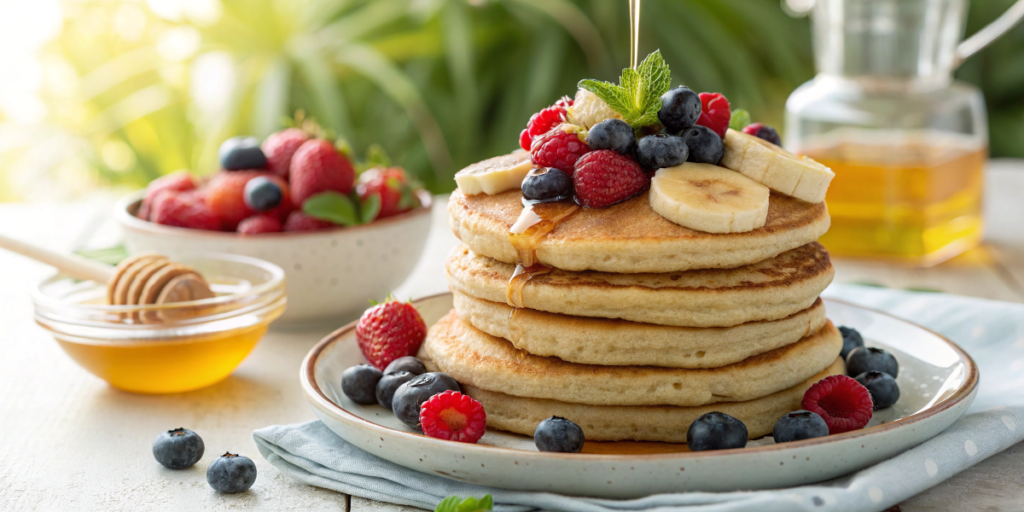
For inspiration, check out buckwheat recipes for healthy ideas to discover easy, flavorful, and nutrient-packed dishes that will make buckwheat a staple in your kitchen.
Quick Lunch Options
For lunch, recipes with buckwheat shine in grain bowls and salads. Cooked buckwheat groats mix perfectly with roasted vegetables, fresh herbs, beans, lentils, or tofu to create filling, protein-rich meals. Add a light dressing for extra flavor, and you have a healthy, balanced lunch that keeps energy levels steady.
Buckwheat can also be used to make wraps or flatbreads. Spread hummus or avocado, add vegetables and protein, and you have a portable meal that is both satisfying and nutritious. These versatile recipes with buckwheat make it easy to enjoy a healthy lunch whether at home or on the go.
Comforting Dinners
Buckwheat works wonderfully in dinner recipes, especially for hearty, comforting meals. Try stir-fries using cooked groats, vegetables, and your choice of protein for a quick, balanced dish. For a more traditional option, use buckwheat in stuffed peppers or zucchini, combining it with herbs, vegetables, and a touch of cheese for a flavorful dinner.
Buckwheat pilafs are another versatile dinner option. Sauté groats with onions, garlic, mushrooms, or leafy greens to create a savory side or main dish. Its nutty flavor adds depth to your meals, making buckwheat an excellent substitute for rice or pasta in everyday cooking.
International Recipes with Buckwheat
Japanese Soba Noodles
One of the most popular recipes with buckwheat worldwide is Japanese soba noodles. Made primarily from buckwheat flour, soba noodles are naturally gluten-free and packed with nutrients. They can be served chilled with a dipping sauce for a refreshing summer meal or hot in soups during colder months. Toss soba with vegetables, tofu, or lean proteins for a balanced and filling dish. Incorporating soba noodles into your weekly meals is an easy way to enjoy the benefits of buckwheat while trying a traditional international recipe.
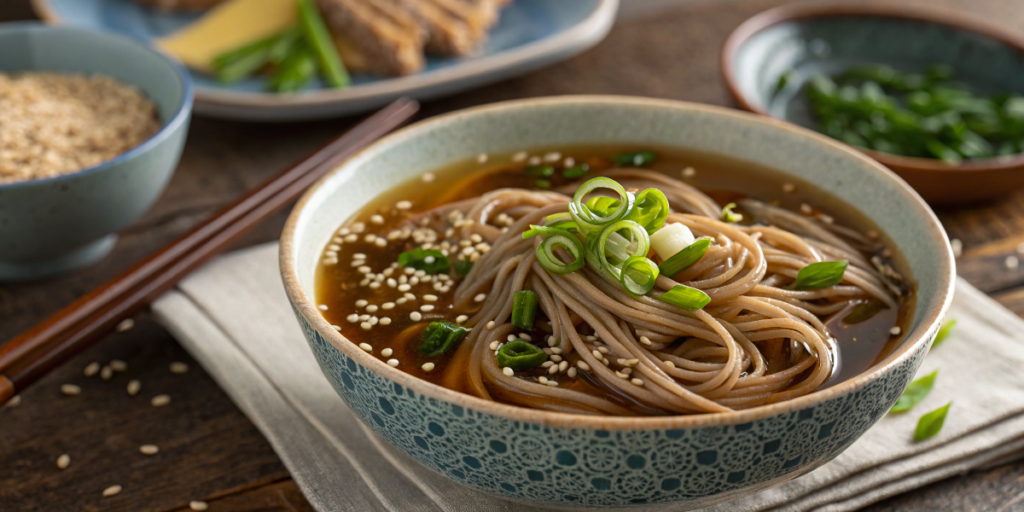
Italian Pizzoccheri
Another iconic dish is Italian pizzoccheri, a type of buckwheat pasta from the Lombardy region. Pizzoccheri is typically combined with potatoes, leafy greens like Swiss chard, and a generous amount of cheese and butter. This hearty dish highlights the versatility of buckwheat, proving it can be part of rich, comforting meals as well as light, healthy ones. For home cooks, experimenting with pizzoccheri allows you to explore authentic Italian flavors while benefiting from buckwheat’s nutrients.
Eastern European Kasha
Kasha, or roasted buckwheat groats, is a staple in Eastern European cuisine and another excellent example of recipes with buckwheat. Kasha can be served as a side dish with sautéed mushrooms, onions, or vegetables, or even as a main meal combined with meats or beans. Its nutty flavor and slightly chewy texture make it a satisfying alternative to rice or other grains. Kasha is also commonly used in salads and baked dishes, demonstrating how versatile buckwheat can be across cultures.
Global Cooking Tips
When preparing international buckwheat dishes, it’s important to rinse the groats well to remove any residual bitterness. Toasting groats lightly before cooking enhances their nutty flavor, which works especially well in kasha or salads. For recipes using buckwheat flour, like soba or pizzoccheri, be sure to blend it with other flours if needed to improve texture, unless you prefer a fully gluten-free version.
By exploring recipes with buckwheat from Japan, Italy, and Eastern Europe, you can enjoy global flavors while reaping the nutritional benefits of this versatile seed. Whether in noodles, pasta, or groats, buckwheat is a worldwide ingredient with endless culinary possibilities.
Buckwheat vs. Rice & Pasta
Healthier Choice?
When comparing grains, recipes with buckwheat often come out ahead of traditional rice or pasta in terms of nutrition. Buckwheat is high in fiber and plant-based protein, which helps you feel fuller for longer and supports steady blood sugar levels. Unlike white rice or refined pasta, buckwheat has a lower glycemic index, making it an ideal choice for people looking to manage weight or maintain energy throughout the day.
Additionally, buckwheat contains essential minerals like magnesium, manganese, and iron, which are less abundant in rice or standard pasta. Its antioxidant content, including rutin and quercetin, also contributes to heart health and inflammation reduction. Incorporating recipes with buckwheat into your meals can help you get more nutrients without adding extra calories.
Culinary Versatility
Another reason to choose buckwheat over rice or pasta is its versatility in cooking. Recipes with buckwheat can range from sweet breakfasts like porridge and pancakes to savory dinners like stir-fries, pilafs, and baked dishes. Buckwheat flour can also be used in gluten-free baking, allowing for creative recipes such as muffins, brownies, or flatbreads.
In comparison, rice and pasta are often limited to savory dishes or specific cuisines, whereas buckwheat can adapt to multiple cooking styles. This flexibility makes it a valuable ingredient for anyone experimenting with healthy, diverse meals.
Taste and Texture
Buckwheat offers a unique nutty flavor that adds depth to dishes, unlike the milder taste of rice or pasta. Its slightly chewy texture makes it satisfying in salads, soups, or baked recipes. By exploring recipes with buckwheat, you not only enhance nutritional content but also introduce new flavors and textures to your cooking.
Cooking & Storage Tips
Perfect Cooking Ratios
One of the easiest ways to make the most of recipes with buckwheat is by following proper cooking ratios. For buckwheat groats, a common guideline is 1 cup of groats to 2 cups of water, simmered for about 15 minutes until tender. Toasting the groats lightly before boiling enhances their nutty flavor, making your dishes more aromatic and flavorful.
For buckwheat flour, it’s important to remember that it behaves differently from wheat flour. When making pancakes, crepes, or baked goods, it’s often best to mix buckwheat flour with other flours to improve texture while keeping it gluten-free. By experimenting with these ratios, you can perfect your favorite recipes with buckwheat.
Batch Cooking & Storage
Buckwheat is ideal for meal prepping. Cooked groats can be stored in the refrigerator for 3–4 days, making them convenient for quick breakfasts, salads, or dinners. Freezing cooked buckwheat is also an option; simply portion it into airtight containers and defrost as needed.
Keeping pre-cooked buckwheat on hand allows you to whip up recipes with buckwheat in minutes, whether it’s a stir-fry, grain bowl, or breakfast porridge. This not only saves time but also encourages consistent healthy eating.
Using Buckwheat Flour
Buckwheat flour is a versatile ingredient for both sweet and savory dishes. You can create pancakes, muffins, and cookies, or use it in breads, crepes, and pizza dough. When using buckwheat flour alone, the texture can be denser, so pairing it with other gluten-free flours often yields lighter results.
Adding buckwheat flour to your pantry opens up endless possibilities for recipes with buckwheat, from hearty main courses to wholesome snacks and desserts. Experimenting with flour and groats in different recipes allows you to enjoy both traditional and creative dishes with this nutrient-rich ingredient.
Modern & Creative Uses
Gluten-Free Baking
Buckwheat flour has gained popularity in modern kitchens, especially for gluten-free baking. By incorporating buckwheat flour, you can make recipes with buckwheat such as muffins, brownies, and banana bread that are both nutritious and delicious. Its nutty taste adds depth to baked goods, and combining it with other gluten-free flours like almond or oat flour improves texture and rise.
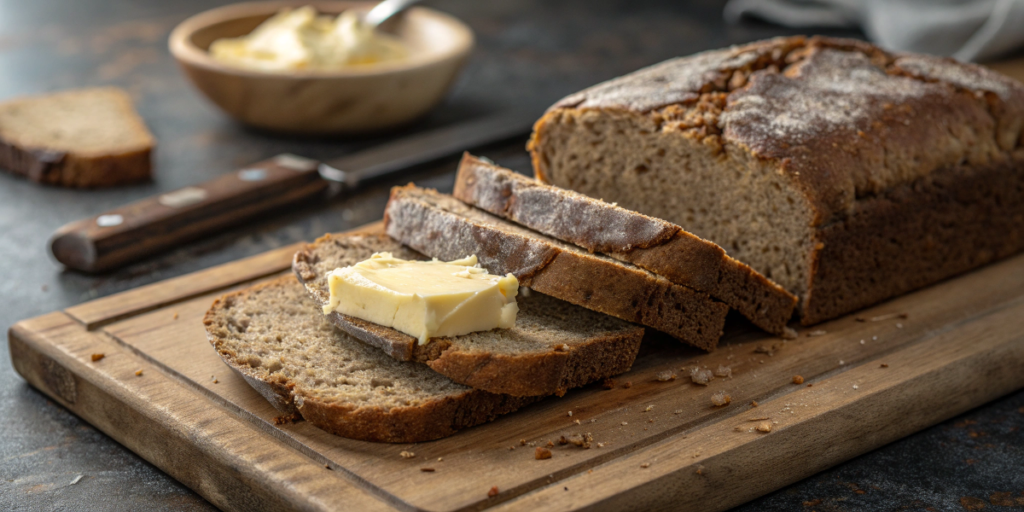
Snacks & Sweets
Buckwheat isn’t limited to main meals—it works wonderfully in snacks and desserts. Granola bars, energy bites, and cookies made with buckwheat groats or flour provide a healthy boost. Toasted groats can be sprinkled over yogurt or smoothie bowls for extra crunch and protein. With these versatile ingredients, creating recipes with buckwheat that satisfy both sweet and savory cravings becomes simple.
Trendy Recipes
Modern chefs and home cooks alike are experimenting with buckwheat in innovative ways. Try veggie burgers with cooked groats, savory buckwheat crepes, or even smoothie bowls with buckwheat for added fiber. These creative dishes highlight the flexibility of buckwheat and show that recipes with buckwheat can be both healthy and trendy.
By exploring modern and creative uses, you can enjoy buckwheat in everyday meals and special recipes alike. From baking to snacks and trendy dishes, there’s no limit to what you can make with this nutrient-packed ingredient.
FAQs About Buckwheat
What can I make out of buckwheat?
Buckwheat is incredibly versatile. You can make recipes with buckwheat including porridge, pancakes, muffins, noodles, salads, grain bowls, and even savory dishes like stuffed peppers or stir-fries. Its nutty flavor works well in both sweet and savory preparations.
What is the best way to eat buckwheat?
The best ways to enjoy buckwheat include cooking groats as porridge, using buckwheat flour in pancakes or baked goods, and incorporating cooked groats into salads or grain bowls. Toasting groats before cooking enhances their flavor, making recipes with buckwheat even more delicious.
Why do I feel good after eating buckwheat?
Buckwheat is rich in fiber, protein, and complex carbohydrates, which provide slow-release energy and support digestion. It also contains tryptophan, an amino acid that can improve mood, which is why including recipes with buckwheat in your diet can make you feel energized and satisfied.
Is buckwheat very healthy?
Yes! Buckwheat is gluten-free, high in antioxidants, fiber, and essential minerals like magnesium and iron. Eating buckwheat regularly supports heart health, digestion, and blood sugar control, making recipes with buckwheat a nutritious addition to any meal plan.
Why avoid buckwheat?
While buckwheat is generally safe, some people may dislike its earthy taste or find raw groats hard to digest. Rarely, allergies can occur. Cooking or toasting groats can minimize these issues and make recipes with buckwheat more enjoyable.
Is buckwheat healthier than rice or pasta?
In many ways, yes. Buckwheat offers more fiber, protein, and nutrients than white rice or refined pasta, and it has a lower glycemic index. Incorporating recipes with buckwheat into meals can make your diet more nutritious and balanced.
Conclusion
Recipes with buckwheat are a delicious and nutritious way to enhance your meals while supporting overall health. From breakfast porridges and pancakes to international dishes like soba noodles, pizzoccheri, and kasha, buckwheat offers endless versatility. Its rich fiber, protein, and mineral content make it an excellent alternative to rice, pasta, or other grains, while its nutty flavor adds depth and texture to every dish.
Incorporating buckwheat into your cooking is simple and rewarding. Whether you prefer sweet recipes, savory meals, or creative snacks, there are countless recipes with buckwheat to suit every taste. Plus, with proper cooking and storage tips, you can enjoy buckwheat quickly and conveniently throughout the week.
By exploring both traditional and modern uses, from hearty dinners to trendy snacks, you’ll see why buckwheat has earned its place as a superfood. Experimenting with recipes with buckwheat allows you to enjoy nutritious, satisfying meals that are as delicious as they are good for you.
Start cooking today and discover just how versatile and beneficial buckwheat can be for your diet!
